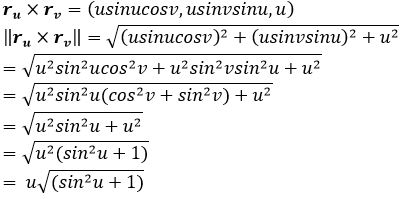Everyone must have seen and used umbrella once in their lifetime. In the rainy days, umbrella is a must-have thing while going somewhere. Monsoon has already started in Nepal and many villagers have already started sowing rice seeds. However, very few people wonder about the structure and shape of the umbrella. Looks like the truncate of sphere, umbrella is beautiful in its own structure and design, thanks to different colors and designs that makes it beautiful as a lotus flower.
Now, I would like you to wonder one thing.
Have you ever heard of cosine cup?
Most probably, not. Even before I came up with this term, I hadn't listened. I was doing some mathematics on surfaces obtained by revolving things about some axis and this thing, cosine cup, a surface of revolution came up. There may even be umbrella designed on this shape. Who knows?!
Let's learn about cosine cup here.
Cosine cup is the surface of revolution formed by revolving simple cosine curve(restricted to some domain) about the symmetric coplanar axis.
The mathematical formulation of the surface would be in parametric form:
Now, I would like you to wonder one thing.
Have you ever heard of cosine cup?
 |
Most probably, not. Even before I came up with this term, I hadn't listened. I was doing some mathematics on surfaces obtained by revolving things about some axis and this thing, cosine cup, a surface of revolution came up. There may even be umbrella designed on this shape. Who knows?!
Let's learn about cosine cup here.
Cosine cup is the surface of revolution formed by revolving simple cosine curve(restricted to some domain) about the symmetric coplanar axis.
The mathematical formulation of the surface would be in parametric form:
So, the position vector of any point in the space would be:
Now, we take its partial derivatives and cross product it. The cross product when multiplied with dudv and taken absolute value, would give area of the infinitesimally small parallelogram* and then we would integrate it to find area of the whole surface under the given domain.
So,
Taking cross-product and its absolute value,
Now, we would integrate the magnitude multiplied by dudv, within the range as said in the domain.
Here, we use Wolphram|Alpha to calculate the definite integral.
So, we would get the total surface area:
Checking:
The cosine cup looks like a hemisphere. So, they must have their surface areas approximately equal.
Let's check that now.
The surface areas don't differ much. So, yes, our method and calculation, both are correct. Cheers!
Unexplored surface and its applications:
This surface is not/has not been talked and analyzed much unlike elliptical and spherical surfaces. However, significances of this particular surface and possible applications can't be ruled out without proper analysis. Be it analysis of fluid flow through such surface or stress/strain/thermal analysis in such surfaces, the research is still to be carried out.
*For people who are interested in how the cross-product magnitude multiplied by dudv gives the differential area, I would like to give a small clarification. Partial derivative of the position function with respect to u multiplied by du gives the differential length vector along direction of u. Similarly, partial derivative of the function with respect to v multiplied by dv gives the differential length vector along direction of v. The two differential length vectors form two adjacent sides of a parallelogram and when they are cross-product-ed and taken magnitude, gives area of the differential parallelogram. du and dv comes out and takes the form we have used in our analysis.









We can obtain an explicit expression of this surface:
ReplyDeletex*x + y*y = u*u
therefore:
z = cos(sqrt(x*x+y*y))
The double integral on dx and dy from 0 to pi/2 woud give the same result.
oops...
ReplyDelete.... would give the volume.
No: the surface
DeleteGreat and I have a neat give: kitchen contractor
ReplyDelete